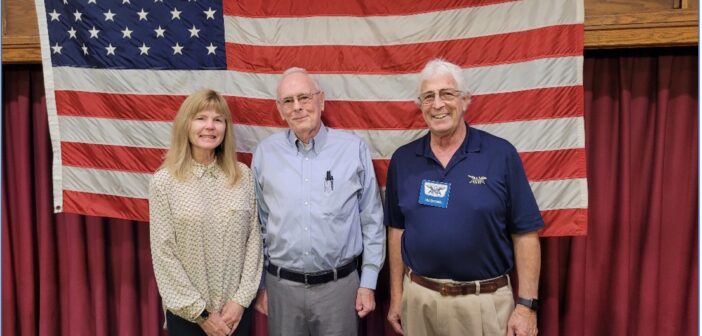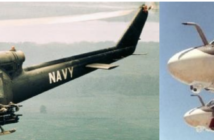At their September 2024 meeting, the Grampaw Pettibone Squadron were privileged to have Major Hammond “Hamm” Salley, US Army Infantry (Ret) speak about the siege of Khe Sanh, Vietnam that took place from January – April 1968. The Major is one of the very few Army officers to receive a Navy Presidential Unit Citation for his association with the 26th Marines during the siege.

Hamm attended the University of Florida and received an Army ROTC commission in the Infantry. He served 21 years in assignments in the United States, two tours in Germany during the Cold War and two tours in Vietnam. Hamm has served in Armored, Airborne and Mechanized Infantry Divisions, as well as Special Ops units. He is Airborne, Ranger and Special Forces qualified.
Hamm began his presentation by introducing himself as a proud “Army Brat”. Referencing military history, Hamm explained that the term was used in the British military. It was an acronym for British Regiment Attached Traveler. However, as the son of a career military officer, Hamm shared with his listeners that he was in trouble much of the time, being an embarrassment to his family. He wished he could apologize to them for his actions as a child. However, life as a dependent did leave him with a focus for a future career, a career in the Army. That commitment was also carried on by both his own sons, who served in the U.S. military.
Hamm described the fundamental causes that led to the U.S. involvement in Vietnam after the French loss at Dien Bien Phu in 1954. In 1954 the Southeast Asia Collective Defense Treaty, also known as the ‘Manila Pact’ was created. This led to the creation of SEATO (South East Asian Treaty Organization) and the legal framework for continued involvement in Vietnam.
The Siege of Khe Sanh took place during the Tet Offensive. Tet is the Vietnamese Lunar New Year and the Tet Offensive which began on January 31, 1968 was one of the largest campaigns of the Vietnam War. It was launched simultaneously by both the North Vietnamese Army (NVA) and Viet Cong (VC) country wide. It involved 44 capitals and 100 cities and attacks against the South Vietnamese Army, US Military and allied forces.
Khe Sanh was an obscure USMC outpost in the NW corner of South Vietnam and was manned by 5000 Marines of the 26th Marine Regiment, South Vietnamese Regulars and other allied assets. As part of the Tet Offensive, it was regarded as the largest, bloodiest and most famous battle of the Vietnam War. For 77 days, the outpost was under siege, surrounded by some 20,000+ North Vietnamese Regulars.
The base at Khe Sanh was created and manned because of its strategic location, astride a key North Vietnamese Army infiltration route into South Vietnam, just 14 miles south of the DMZ. It was of strategic, tactical and psychological importance for both the US and NVA. The commanding general of the NVA was General Vo Nguyen Giap, the same General who defeated the French at Dien Bien Phu in 1954.
When Hamm was in Saigon on January 30, 1968 at the beginning of the Tet Offensive, the streets were virtually empty and smoke rose in the distance from enemy attacks.
Hamm was flown into Khe Sanh during the siege as part of the Special Forces unit he was assigned. The helicopter carrying him did not land, but hovered over the landing zone low enough for Hamm to jump out and run for cover. The Khe Sanh Combat Base in South Vietnam was about a mile long and half a mile wide. The base was located on a flat plateau in the middle of four valley corridors and surrounded by forested hills. The original runway built by the French was 1,500 feet long. It was extended by American forces using aluminum planks to 3,900 feet. The northeast quadrant had a barbedwire security fence, mine field and open area. Ditches outside the perimeter were dug by the enemy to sneak in to the wire undetected. The center portion of the base housed the headquarters for the Marine detachment. The boundary along the edge of the base was also arranged with barbedwire, mine field and outside the wire, the enemy dug trenches to approach undetected.

In addition to the Marines manning the base, local mountain tribesmen, referred to as Montagnards, provided assistance in defending the base. They were hired as mercenaries and Hamm described them as reliable and effective in their role. The Marines manned trenches and underground bunkers to reduce the chance of being wounded or killed from artillery fired into the base by the enemy.
Hamm described the surrounding terrain and conditions of the landscape during and after the siege. Air strikes using all manner of aircraft, conducted over 9,000 missions during the siege and dropped over 14,223 tons of bombs.
The base was only resupplied by air, either helicopter or fixed-wing transports. Whenever aircraft arrived, the enemy would fire their artillery from the mountain caves across the nearby Laotian border. The firing would target the aircraft, the runway or any supplies that were being delivered. Many artillery attacks also targeted the ammunition dumps that existed to supply the Marines on base.
On March 30, 1968, operational control of the base was transferred from the 26th Marines to the U.S. Army 1st Cavalry Division (Airmobile). An offensive was initiated by the replacement unit called ‘Operation Pegasus’ to relieve the siege at Khe Sanh. The relief of the base was completed on April 8, 1968. The base was closed and all personnel left the base in July 1968, after all bunkers, trenches and base construction were destroyed.
Hamm presented a summary of the events. The numbers may vary depending on the source.
| 77 Day Siege of Khe Sanh – Results | ||
| US | NVA | |
| Killed in Action | 407+ | 10,000+ |
| Wounded in Action | 2037 | |
| Incoming Rounds | 11,114 | |
| Outgoing Rounds | 117, 600 | |
| Average tons of bombs daily | 1,800 | |
| RESULTS | ||
| Two enemy divisions
were decimated and tied down during ‘Tet Offensive’ |
20,000+
NVA soldiers |
|
| Awards | ||
| Navy Presidential Unit Citation issued to 26th Marines and associated units in May 1968 | ||
Hamm was Army Special Forces assigned to FOB (Forward Operating Base) 3 at Khe Sanh. This was a sub unit of the MACVSOG or MACSOG (Military Assistance Command Vietnam Studies and Observation Group). The unit was Top Secret and involved in cross border operations. Various military and intelligence gathering organizations comprised the groups associated with the operation.
In addition to monitoring enemy movements, part of his team’s assignment was to capture enemy munitions, sabotage and then return them without being noticed to a location where the enemy would find them. When enemy personnel used the booby-trapped munitions, they would explode. This method eliminated enemy personnel and contributed to the psychological warfare against the enemy, hoping they would be suspicious of their issued weapons and ammunition supplies.
Between 1964-1972, SOG units had the highest casualty and kill rates during their time in Vietnam. The results of unit operation led to: significant intelligence of enemy operations, rescue of downed pilots and crew, destruction of large amounts of enemy material and diversion of thousands of NVA troops for rear area security. In April 2001, the SOG received the Army Presidential Unit Citation.
In closing, Hamm reflected on military service: Freedom is not free. You must stay vigilant. Army service was his choice and he would serve again. He had unparalleled paid adventures and enjoyed living in many areas. Military families also serve but don’t receive due recognition. Lessons were learned about leadership, commitment and responsibility. Self-discipline; perseverance and exceeding limitations were ingrained in you. Honor and respect others and have an appreciation for other cultures.

L to R: Cindy Macha – GPS Staff, Hamm Salley – Speaker, Tim Brown – GPS President




